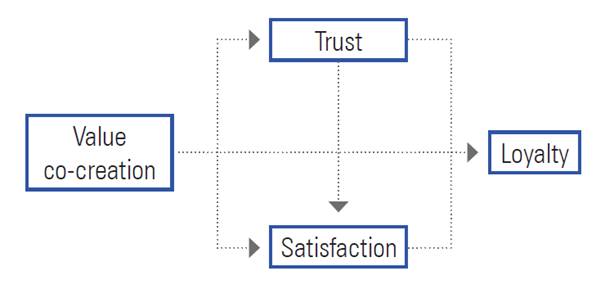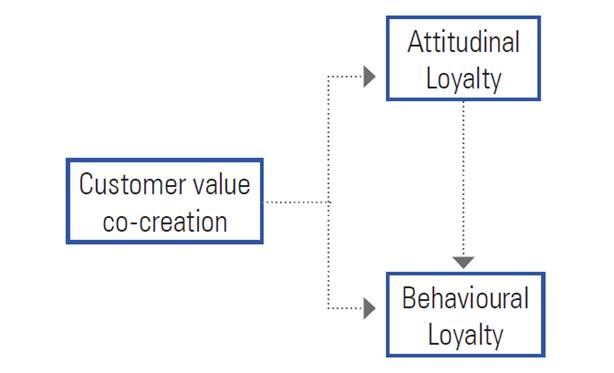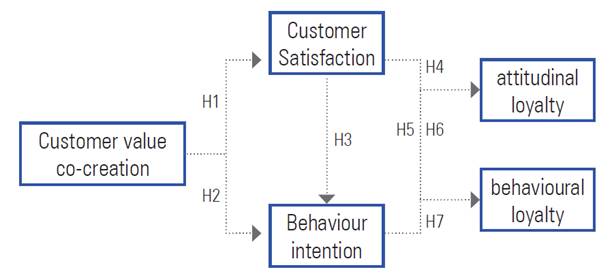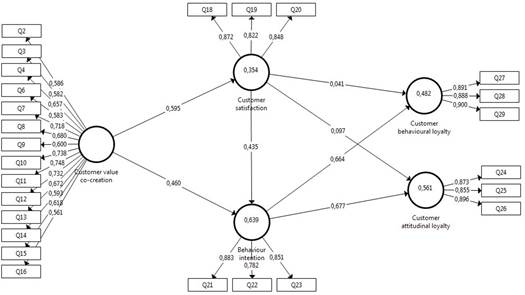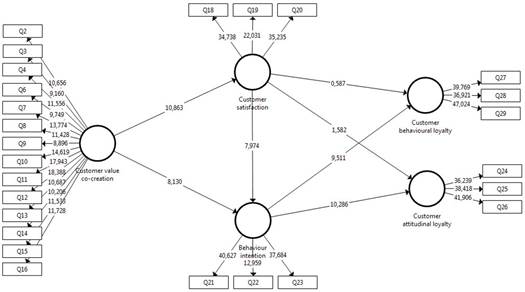1. INTRODUCTION
Recent improvements in technology have not only influenced the management of businesses and business models but have also facilitated customers’ access to information and data of firms (Opata et al., 2020) As a result, now more than ever, customers play an important role in creating value for firms (Galvagno & Dalli, 2014; Opata et al., 2020; Vargo & Lusch, 2016). In Goods Dominant Logic (GDL), the focus is on providing goods and services without heeding the tendencies and preferences of customers (Vargo & Lusch, 2008) while in the core concept of Service-Dominant Logic (SDL) customers are seen as the co-creators of value.
New media organizations and activists have faced challenges such as a change in user behaviour and increased user expectations in this regard. This has prompted them to identify new strategic approaches to achieve sustainable competitive advantage (Aboyee Ardakan & Ghanbary, 2020; Khajeheian et al., 2018) and meet the needs of their customers (Cossío-Silva et al., 2016; Shaw et al., 2011). The emergence of Service-Dominant Logic (SDL) has led to a change in the marketing paradigm and a new approach to the participation of customers in value creation (Rahmanseresht et al., 2018).
The concept of value co-creation focuses on participatory measures and the necessities of organizations and customers to develop solutions to meet the needs of customers and create value (Hamidi et al., 2020; Moghadamzadeh et al., 2020). This is considered a strategic issue since the formation of common values with customers requires planning, alignment, implementation and control of extensive measures at various levels of the organization, (Rahmanseresht et al., 2018).
News media users may participate in co-creation activities to increase their expected benefits by engaging in services that are more compatible with their needs (Prebensen et al., 2016). When users of news outlets receive a high level of value, they express positive behavioural tendencies (Khajeheian & Friedrichsen, 2017; Ghanbary et al., 2021 ). The perceived value encourages them to reuse the news media platform in the future, triggering a positive reaction to word of mouth and as a result, which plays a crucial role in customer loyalty (Ebrahimi et al., 2020).
In addition, value co-creation influences customer satisfaction, which is one of the primary aspects the managers should address. Managers try to satisfy the customers in order to gain a competitive advantage in the market (Cuong, 2020; Yu & Ramanathan, 2012). Customer satisfaction leads to enhanced opportunities of reusing news media, garnering positive and encouraging recommendations of the organization. Therefore, customer satisfaction triggers customer loyalty (Cuong & Long, 2020).
As a source of competitive advantage, customer loyalty is one of the best assets to an organization in terms of attitudes and behaviour. Therefore, loyalty in both terms is important for market knowledge development and the activities of the business. Customer value co-creation provides opportunities to build relationships that help foster loyalty and reduce the potential for customers to end their relationship with the company (Emami et al, 2021; Revilla-Camacho et al., 2015). From this perspective, customer loyalty is one way to help achieve value creation and therefore a competitive advantage.
Customer value co-creation, customer satisfaction and behavioural intention can also increase the level of user loyalty. In this study, the direct effect of these factors has been investigated. The relevance of this research lies in the impact of these factors on customer loyalty and its effects on achieving organizational success. A loyal customer reduces the cost of attracting and serving a new customer, contributing to a real competitive advantage (Cossío-Silva et al., 2016). This research aims to determine the impact of customer value co-creation, satisfaction, and behavioural intention on customer loyalty.
2. THEORETICAL DEVELOPMENT AND RESEARCH MODEL
Nowadays, with increasing competition in the service sector, the role of customer loyalty has become more prominent than ever. Marketing includes development and attention to satisfaction, quality from the perspective of customers, loyalty, and effective communications with customers (Nemati & Khajeheian, 2018). As a result, it is integral that modern organizations have loyal customers (Meyer-Waarden, 2015). The role of loyalty is very important, since extensive interpersonal relations exist between service providers and customers in the service sector. Customer loyalty leads to increased market share, return on capital, and higher profitability for service organizations. Customer loyalty is one of the most inspiring and important factors influencing marketing success, particularly in the media industry.
Recent literature indicates a change in marketing philosophy. This change includes active customer participation in the value co-creation process (Moise et al., 2020). Today’s customers are more informed, selective, educated and empowered, therefore they can exert great influence on the value generation for an organization (Vega-Vazquez et al., 2013). Customer value co-creation not only leads to improvements in innovation and identifying customer needs, but also it increases the level of customer loyalty and satisfaction (Moise et al., 2020).
For modern organizations, one part of harbouring customer loyalty involves ensuring that customers are satisfied (Lee & Connolly, 2010). Customer satisfaction is deemed as the main success factor in many organizations. In various studies, the relationship between customer satisfaction and word of mouth communication, loyalty, repurchasing, and increased profitability of organizations has been addressed (Sarkar Sengupta et al., 2015).
Moise et al. (2020) explored the connections between value co-creation and customers' trust, loyalty, and satisfaction. The results revealed that customer participation in the value co-creation process positively affected these three factors. Furthermore, trust and satisfaction were positively linked with customer loyalty (Figure 1).
Moise et al. (2020) considered customer loyalty a single variable, while according to the research of Cossío-Silva et al. (2016) there are two classes of loyalty: attitudinal loyalty and behavioural loyalty. Both dimensions of loyalty are affected by customer value co-creation (Figure 2).
The studies also suggest that besides customer value co-creation and satisfaction, behavioural intentions can be considered as an indicator of influence on loyalty. Behavioural intentions signal expectations about behaviours, particularly under certain contexts, and are defined as the predictors of behaviour in the future in terms of operational stance.
2.1 customer value co-creation and customer satisfaction and behaviour intention.
According to Prahalad & Ramaswamy (2004), traditionally customers were considered as passive elements of the value creation process inside the company which was finally received by the customers. However, the roles of customer and seller are very vague and the border between them has vanished in the contemporary context. Now, customers are considered as value creation resources who contribute to competitive advantage and have an important role in the improvement and innovation of products and services (Soltani et al., 2016). Value co-creation is a mutual process based on collaboration, synchronicity, and similarity that creates a new value both materially and symbolically (Gummesson et al., 2014).
In this respect, most organizations create value and engage with their customers to survive. By doing so, they are able to provide services that are fully adjusted to the needs of their customers (Vega-Vazquez et al., 2013). Additionally, if this value is generated with customers, it could enhance greater customer satisfaction (Moise et al., 2020). Several studies have highlighted that active consumer value co-creation improves their satisfaction (Grissemann & Stokburger-Sauer, 2012; Hollebeek & Rather, 2019; Mathis et al., 2016). Based on this, the following hypothesis was considered:
H1: Customer value co-creation positively affects customer satisfaction.
Behavioural intentions point to the performance of services that customers receive and whether customers are willing to increase or decrease their interaction with a particular news media platform (Huang et al., 2015). Behavioural intentions of customers are (Chen et al., 2013) behavioural that can be both desirable and undesirable (Emami and Klein, 2020; Fu et al., 2018). Customer value co-creation can boost customers’ behavioural intentions. Therefore, researchers propose the following hypothesis:
H2: Customer value co-creation positively affects behavioural intention.
2.2 Customer satisfaction and behaviour intention
Research has shown that customer satisfaction greatly affects behavioural intention (Cuong, 2020; Xiao et al., 2020). Satisfied customers are likely to reuse previously received services (Ratnasari et al., 2020) as well as recommend them to others (Liao et al., 2017). When customers repeat a transaction or return to that service, it strengthens their behavioral intentions. Therefore customer satisfaction plays a significant and positive role in behavioural intention (Cuong, 2020; Wu, 2014; Chen et al., 2013). Researchers propose the following hypothesis:
H3: Customer satisfaction positively affects behavioural intention.
2.3 customer satisfaction, behaviour intention and customer loyalty (attitudinal and behavioural)
Customer loyalty is a complex term. The accepted definition of loyalty is where a customer is committed to return to the organization or company to reuse the service or repurchase a product. It can also include promoting its repeated use or purchase. Loyal customers are known to revisit the same news media agencies, recommend those organizations, and maintain an optimistic attitude toward them (Kandampully & Suhartanto, 2000).
According to established research, there are two types of loyalty (Baloglu, 2002; Kumar et al., 2006): behavioural and attitudinal. Behavioural loyalty refers to the actions and habits of a customer. Attitudinal loyalty is a personal viewpoint or opinion where different emotions make up the loyalty of consumers toward a product, a service, or a retailer (Cossío-Silva et al., 2016; Kursunluoglu, 2011).
Previous investigations have shown that customer satisfaction positively affects loyalty (Chen & Wang, 2016) and customer satisfaction has led to enhanced chances of reusing, recommending and providing encouragement to the organization (Han & Ryu, 2009; Minta, 2018).
Additionally, behaviour intentions have been thoroughly examined in marketing literature. In general, behavioural intentions are associated with customer loyalty (Alexandris et al., 2002; Chen et al., 2013), and customer loyalty is influenced by customer satisfaction (Chen et al., 2013). As customer behavioural intentions involve a large amount of decision-making, particularly in reuse decisions (White & Yu, 2005), customer behavioural intentions, are thus related to customer satisfaction and customer loyalty (Chen et al., 2013; Kang et al., 2004).
It is also suggested that two types of loyalties (attitudinal and behavioural) can be affected by customer satisfaction and behaviour intentions (Chen et al., 2013). Thus the following hypotheses are proposed:
H4: customer satisfaction positively affects customer attitudinal loyalty. H5: customer satisfaction positively affects customer behavioural loyalty. H6: behaviour intentions positively affect customer attitudinal loyalty.
H7: behaviour intentions positively affect customer behavioural loyalty.
Subsequently, the conceptual model of the present research is adopted from the models of Moise et al. (2020) and Cossío-Silva et al. (2016). This study analyses the role of customer value co-creation, customer satisfaction, and behavioural intention on customer loyalty. The conceptual model of this research is shown in Figure 3
3. METHODOLOGY
3.1 Population of study
The Fars News Agency, describing itself as "Iran's leading independent news agency", has been the subject of this study. This organization manages different social media accounts including Twitter, Facebook, Instagram, and Telegram, and they also have a mobile application to share the news and allow their customers to interact with the news agency.
"My Fars" is the new system of Fars News Agency that aims to make their content more targeted and relevant to their audience. The audience can select a wide range of content and news in scopes such as "request to address major issues'', "request for appreciation", or "suggestion and criticism", or to ''follow” or ''publish”. "My Fars" is an attempt by Fars News Agency to popularize media and understand the audience's interests. The technology used by My Fars provides opportunities for widespread participation of the users, leading to significant levels of customer co-creation. Thus, all users of “My Fars" are the population of this study.
3.2 Measures, reliability, and validity
To test the hypotheses of the model, an online survey was used. This online questionnaire was designed based on a 5-point Likert scale from absolutely disagree (1) to absolutely agree (5) and involves 29 questions. 17 questions were developed to measure the variable of Customer Value Co-Creation, and three questions for each of the other variables.
To examine the internal consistency reliability and convergent validity the PLS- SEM evaluation process was observed. In the section of measurement model indexes, the main criterion is convergent validity or AVE that should reach a critical level of 0.04 that indicates internal consistency or validity of the reflective measurement models. The results show the convergent validity is confirmed for all variables except customer value co-creation. In Table 1, values related to convergent validity, composite reliability, and Cronbach’s alpha for each construct are presented. As can be seen, all Cronbach’s alpha values of the variables are above 0.7 which amounts to acceptable reliability. Since the CR criterion is much better than Cronbach’s alpha, the findings in Table 1 show that all CR values for all constructs are larger than 0.7 and show acceptable internal consistency (Hair et al., 2016).
The factor load shows the power of the relationship between the observable and latent variables. A path coeficient greater than 0.5 is desirable and the outer loadings that have a lower value of 0.5 should be deleted from the model (Hair et al., 2016).
Variance Inflation Factor (VIF) has been used to assess Multicollinearity among independent variables. For this factor, values lower than 2.5 are favourable (Hair et al., 2016). According to Table 2, there is no Multicollinearity among the independent variables.
Table 1: Measurement models and measures
| Factors and items | outer loading | Cronbach’s alpha | Composite Reliability | Average Variance Extracted (AVE) | |
| Q2 | 0.586 | ||||
| Q3 | 0.582 | ||||
| Q4 | 0.657 | ||||
| Q6 | 0.583 | ||||
| Q7 | 0.718 | ||||
| Q8 | 0.680 | ||||
| Customer value co-creation | Q9 | 0.600 | |||
| Q10 | 0.738 | 0.894 | 0.911 | 0.424 | |
| Q11 | 0.748 | ||||
| Q12 | 0.732 | ||||
| Q13 | 0.672 | ||||
| Q14 | 0.593 | ||||
| Q15 | 0.618 | ||||
| Q16 | 0.561 | ||||
| Q18 | 0.872 | ||||
| Customer satisfaction | Q19 | 0.822 | 0.806 | 0.884 | 0.718 |
| Q20 | 0.848 | ||||
| Q21 | 0.883 | ||||
| Behaviour intention | Q22 | 0.782 | 0.791 | 0.877 | 0.705 |
| Q23 | 0.851 | ||||
| Q24 | 0.873 | ||||
| Customer attitudinal loyalty | Q25 | 0.855 | 0.847 | 0.907 | 0.766 |
| Q26 | 0.896 | ||||
| Customer behavioural loyalty | Q27 | 0.891 | 0.873 | 0.922 | 0.798 |
Table 2: Multicollinearity with VIF
| Behaviour intention | Customer attitudinal loyalty | Customer behavioural loyalty | Customer satisfaction | Customer value co-creation | |
| Behaviour intention | 2.010 | 2.010 | |||
| Customer attitudinal loyalty | |||||
| Customer behavioural loyalty | |||||
| Customer satisfaction | 1.547 | 2.010 | 2.010 | ||
| Customer value co-creation | 1.547 | 1.000 |
4. DATA ANALYSIS AND FINDING
According to Table 3, the highest density of age levels was 23 to 37 years old and 28 to 50 with a frequency of 108 and 38%. Female users with a frequency of 88 and 13% and male users with a frequency of 244 and 86% participated in this study. Bachelor’s degree holders comprised the largest group of the participants compared to PhD holders (8%) followed by post-diploma degree. Half of the users of news media spent 2 to 6 hours on the internet per day (50%). The average time they spend on the news was less than 3 hours and most of them spent an average of between 1 and 3 hours following the news on the My Fars platform. The smartphone was the most popular electronic device used for following the news.
Structural Equations Modelling (SEM) employing Smart PLS was used to analyse the data and test the research hypotheses, this research is focused on the prediction of both independent and dependent variables and the conceptual model is researcher- based and exploratory. Therefore, in this study, PLS-SEM was used.
Indeed, the coeficient of determination shows the effect that a dependent variable has on an independent variable and a larger coeficient shows further explanation of the dependent variable by the independent variable or variables. According to Table 4, R^2 values for the indigenous constructs of the model are as follows: Customer satisfaction 0.354, Behaviour intention 0.639, Customer attitudinal loyalty 0.561 and Customer behavioural loyalty 0.482. A larger coeficient means that the variable or variables have explained a large amount of the dependent variable variance and the model indicates better GOF among the constructs.
Table 3: Demographics features
| Features | Levels | Frequency | Percentage (%) |
| Gender | Male | 244 | 86% |
| Female | 38 | 13% | |
| 16-22 years | 22 | 8% | |
| Age | 23-37 years | 108 | 38% |
| 38-50 years | 107 | 38% | |
| 51 years or more | 43 | 15% | |
| Diploma and less | 36 | 13% | |
| Post diploma | 28 | 10% | |
| Level of education | Bachelor | 107 | 38% |
| Master | 89 | 31% | |
| PhD | 23 | 8% | |
| less than 2h | 53 | 19% | |
| The average time use from the internet (per day) | 2-6 h | 142 | 50% |
| 6-10 h | 57 | 20% | |
| More than 10 h | 29 | 10% | |
| less than 1h | 104 | 37% | |
| The average spending time for following news (per day) | 1-3 h | 122 | 43% |
| 3-5 h | 32 | 11% | |
| More than 5 h | 22 | 8% | |
| less than 1h | 82 | 29% | |
| The average time for using My Fars (per day) | 1-3 h | 109 | 39% |
| 3-5 h | 36 | 13% | |
| More than 5 h | 53 | 19% | |
| Mobile | 231 | 82% | |
| The devices that usually use to follow the news | Tablet | 8 | 3% |
| Laptop | 13 | 5% | |
| Computer | 29 | 10% |
Figure 4 and Figure 5 show path coeficients and T values. The index Q^2 was used to predict the power of the model that consists of the construct of cross-validated redundancy (CC-Red) and cross-validated communality (CC-Com). A value that approaches 1 represents the most conducive response (Khajeheian & Ebrahimi, 2020). Also measure SRMR has been implied to assess the whole model, including internal and external structural models, that values lower than 0.08 are considered as favourable (Hair et al., 2016). In this research, the value of SRMR in the Estimated model and Saturated model are reported as 0.07.
Table 4: Assessment of structural model indicators
| R Square | R Square Adjusted | CC-Red | CC-Com | |
| Behaviour intention | 0.639 | 0.637 | 0.439 | 0.400 |
| Customer attitudinal loyalty | 0.561 | 0.558 | 0.417 | 0.506 |
| Customer behavioural loyalty | 0.482 | 0.478 | 0.372 | 0.561 |
| Customer satisfaction | 0.354 | 0.351 | 0.239 | 0.420 |
| Customer value co- creation | --- | --- | --- | 0.331 |
Hypotheses 1 to 5 were considered to test the direct effect. Table 5 shows all these hypotheses except H4 and H5 is confirmed at the 95% confidence level.
Table 5: Results of research hypotheses
| Hypotheses | β | SD | t-statistics | p-value |
| Behaviour intention -> Customer attitudinal loyalty | 0.677 | 0.066 | 10.286 | 0.000 |
| Behaviour intention -> Customer behavioural loyalty | 0.664 | 0.070 | 9.511 | 0.000 |
| Customer satisfaction -> Behaviour intention | 0.435 | 0.055 | 7.974 | 0.000 |
| Customer satisfaction -> Customer attitudinal loyalty | 0.097 | 0.061 | 1.582 | 0.114 |
| Customer satisfaction -> Customer behavioural loyalty | 0.042 | 0.070 | 0.587 | 0.558 |
| Customer value co-creation -> Behaviour intention | 0.460 | 0.057 | 8.130 | 0.000 |
| Customer value co-creation -> Customer satisfaction | 0.595 | 0.055 | 10.863 | 0.000 |
5. DISCUSSION AND CONCLUSIONS
Loyalty plays a key role in an organization's success and is recognized as an important and determining factor in its growth and profitability. This study explores the relationship between customer co-creation and loyalty, customer satisfaction and behavioural tendencies. Based on the above-mentioned results of the research, the following findings are presented:
Hypothesis 1 that pertains to the relationship between customer value co-creation and customer satisfaction and hypothesis 6 that test the relationship between behavioural intentions and customer attitudinal loyalty have been confirmed as the strongest hypotheses (H1: β = 0.0595, t = 10.863, p = 0.000 and H6: β = 0.0677, t = 10.286, p = 0.000).
Therefore according to the research findings, the construct of value co-creation could influence the construct of customer satisfaction dramatically. This means higher participation and interaction of customers boost customer satisfaction. This interaction and participation can be shaped during the process of news production and suggesting ideas for campaigns. That is to say, the users of news media get engaged in the process of producing news. In other words, a user-based, participatory approach gets underway through which strong user interaction is shaped which in turn gives rise to new demands and develop the services using new insights. Similarly, behavioural intentions can play an important role in attitudinal loyalty.
Based on the analysis, hypotheses 2,3 and 7 have been confirmed strongly (H2: β = 0.460, t = 8.130, p = 0.000; H3: β = 0.435, t = 7.974, p = 0.000; H7: β = 0.664, t = 9.511, p = 0.000), respectively showing the respective effects of customer value co-creation on behavioural intentions, customer satisfaction on behavioural intentions, and behavioural intentions on behavioural customer loyalty.
Through interacting with news platforms to select news based on their interests, users create the values and according to the second hypothesis which has already been confirmed such value co-creation can influence behavioural intentions. According to H3, the satisfaction that triggers a behaviour has been very effective in shaping the behavioural intentions and can enhance them. In hypothesis 7, the relationship confirms that the intention of the past behaviour largely determines effective behaviours and brings about attitudinal loyalty.
Finally, no corroboration is found in hypotheses 5 and 6. Therefore, the results do not confirm the assumption that customer satisfaction has a direct effect on both types of loyalty towards the organization, especially in the news industry. While most of the researchers claimed that customer satisfaction was significantly related to customer loyalty (Jiang et al., 2018; Hultman et al., 2015; Prayag & Ryan, 2012), the results of this study show that there is no relationship between satisfaction and loyalty of customers. This is an important finding, as it might imply that the potential for news organizations to increase both attitudinal and behavioural loyalty among their target audience does not depend substantially on users’ satisfaction. A plausible explanation for this finding could come from the differences between the natures of news organizations and other companies.
According to the results of the analysis in this study, it is recommended that news agencies produce news stories based on interaction with their users. This can be implemented by receiving suggestions, comments, and criticisms from the users on the relevant platforms to explore values users care about. Such value co-creation can in turn improve customer satisfaction, behavioural intentions, and customer loyalty.
5.1 Limitations and Future Research
There are a few limitations to the current research that can be lifted in future studies. Firstly, this study was conducted in a particular context with certain restrictions in co- creation. Thus, co-creation and loyalty that are under-researched in other industries should be taken into consideration. Also, this research constricted its perception of co-creation to sharing the news content on the news media platform. However, co- creation carries a broader meaning and is not limited to sharing the content and ideas in the news platform. This issue can be considered in future research. Finally, this study uses cross-sectional data from Iranian users for a specific news media. Thus, using a longitudinal research design is recommended for further research to better ascertain the nature of and the relationships among constructs.













